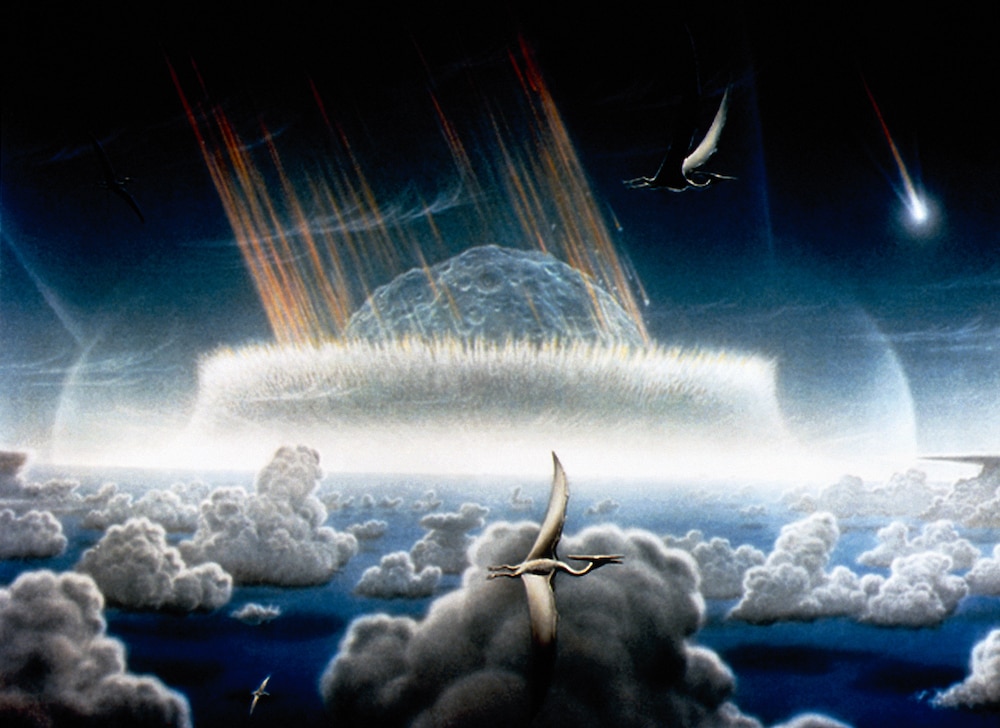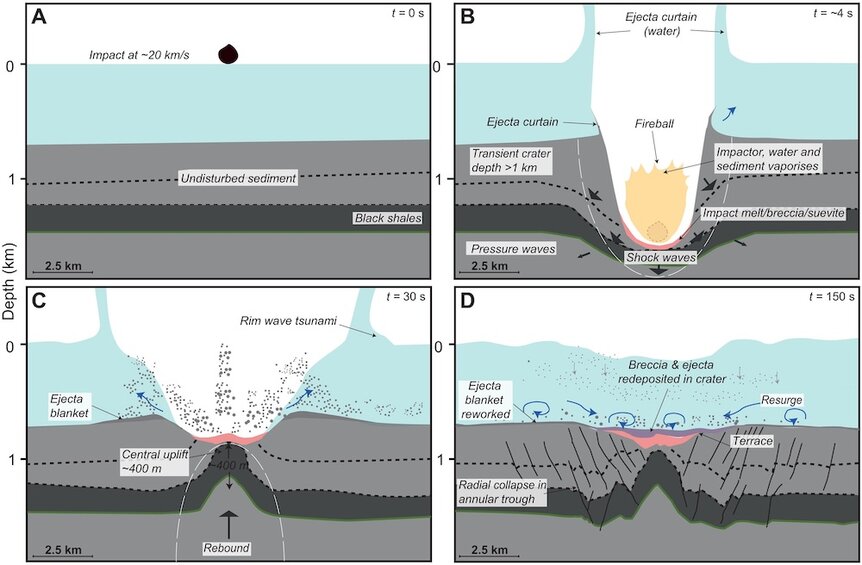Create a free profile to get unlimited access to exclusive videos, sweepstakes, and more!
Dinosaurs might have been double tapped by not one but two asteroids
Sometimes the universe kicks you when you're down.

The hypothesis that a large asteroid was responsible for the extinction of the dinosaurs is almost universally accepted today, but it is the result of relatively recent scientific discovery. The asteroid hypothesis was only proposed in 1980 and wasn’t immediately accepted by the scientific community or the public. However, it pretty quickly gained in popularity — having since been supported by additional evidence — and we’ve had a sort of public fascination and low-lying fear of another impact event ever since.
It's no wonder that movies like Armageddon and Deep Impact were popular in the decades following the discovery, and that similar films continue to be produced. More recently, Don’t Look Up and Seeking a Friend for the End of the World re-imagined what it might be like to live through an extinction level impact.
Death from above isn’t likely, at least not on the scale of a human lifetime, but it makes sense that we would worry about it. Chicxulub was a cosmic pummeling the likes of which Earth has rarely seen. Only the Vredefort crater in South Africa is larger. It is estimated to have been created by an object between 10 and 15 kilometers wide which struck the planet approximately 2 billion years ago. And, of course, there’s also the proposed impact which created the Moon. Those impacts might have been more devastating for the planet, but didn’t have the same consequences for life, having both happened before multicellular life evolved.
When it comes to celestial insults, Chicxulub is the reigning champion, responsible for wiping out roughly 80% of all animals some 66 million years ago, but it’s possible it didn’t act alone. According to a new paper published in the journal Science Advances, scientists have discovered a new potential impact crater in the seafloor off the coast of West Africa which may have served as one half of a one-two punch around the time the dinosaurs died out.
The geological feature, dubbed Nadir, was discovered by Uisdean Nicholson from the School of Energy, Geoscience, Infrastructure and Society at Heriot-Watt University when he was combing through seismic reflection data for an unrelated scientific proposal.
“I expected everything to be flat lying but in the middle of the data set we could see this crater-like feature. It’s about 10 kilometers in diameter with an area of quite intense faulting around it. I went through the thought process of what it could be. Could it be a collapsed volcano, or could it be salt that’s sitting below the surface that’s dissolved and collapsed or something like that? But none of these things were consistent with the geometry of the crater,” Nicholson told SYFY WIRE.
Nicholson then reached out to Sean Gulick at the University of Texas at Austin, co-author on the paper, who looked at the data. “He told me he gets dozens of these messages every week, but when I showed him the crater, he thought it looked like a pretty good candidate,” Nicholson said.
They then set about trying to confirm the date of the feature and model its characteristics. About 400 kilometers away, oil and gas drilling operations have sampled the seafloor sediment and the team used that data to correlate a time-distance relationship with Nadir. That data estimates an age of 66 million years, give or take a million, right around when we think the Chicxulub impact occurred. What’s more, it has what looks like ejected material around the perimeter, something we would expect from an impact.
“The criterion at the moment is you can’t say it’s an impact crater definitively until you recover shocked minerals from the crater floor. It’s a candidate, but the likelihood is good. It has all of the characteristics we would expect of a crater this size,” Nicholson said.
Given the relative infrequency of large impactors it might seem unlikely that two impacts could happen so close to one another, but there are a few not uncommon ways in which this can occur. It’s possible that Chicxulub and Nadir were a binary asteroid, traveling together on an interplanetary road trip, destination: Earth. It’s also possible they began as a single large object which was disturbed by Earth’s gravity on a close pass and broke up. It might also be possible that Nadir was a part of the Earth which got kicked up when Chicxulub hit and then came back down, or that a collision event in the asteroid belt sent a group of objects toward the inner solar system as a group. Figuring out which of these scenarios were responsible, if Nadir is indeed an impact crater, will likely come down to precisely figuring out the sequence of events.
“Secondary impacts arise when a large fragment of the target body, in this case Earth, are ejected, do not achieve escape velocity, and re-impact the target. Several bodies — a good example is Jupiter’s moon Callisto — show what are called crater chain, linear chains of craters, sometimes overlapping, believed to be caused when an impactor is tidally disrupted prior to impact, like Shoemaker-Levy was prior to Jupiter impact in 1994,” said Kevin Grazier, a planetary physicist not involved in the work. “They potentially could also be due to ejecta from other impacts, in other words, a string of secondary impacts. So, although I think there will be more work involved in concretely linking this to Chicxulub, I would argue that secondary impacts are to be expected.”
If it was a second impact, it probably wouldn’t have significantly altered the fate of the dinosaurs and the rest of the animals living on the prehistoric Earth. If Chicxulub was a knockout punch, Nadir was a half-hearted kick in the gut on the way out the door. In terms of energy, Nicholson estimates that Chicxulub was roughly 10,000 times more powerful than Nadir. The second impact might have created tsunamis and earthquakes, but would have largely been a regional event, without the earth-shattering consequences of its larger sibling.
The team is hoping to confirm the impact hypothesis for Nadir by directly sampling the sediment in search of shocked minerals. They have submitted a proposal to the International Ocean Discovery Program, a year-round scientific drilling operation. If all goes well, they’ll be a candidate for drilling sometime in 2024 and 2025.
“That would be a golden ticket for us. It would allow us to test whether it’s an impact crater and confirm the aging all in one go,” Nicholson said.
If confirmed, we’ll know that humans aren’t the only ones who seek friends for the end of the world. Impactors have buddies too, and asteroids that fly together, die together.



























